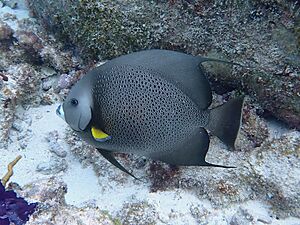Gray angelfish facts for kids
Quick facts for kids Gray angelfish |
|
|---|---|
 |
|
| Conservation status | |
| Scientific classification | |
| Synonyms | |
|
The gray angelfish (Pomacanthus arcuatus) is a beautiful fish found in the Western Atlantic Ocean. It is also called the grey angelfish or, in Jamaica, the pot cover. This fish belongs to a group of marine angelfish known as the Pomacanthidae family.
Contents
About the Gray Angelfish
The gray angelfish has a body shaped like a flat disk, which means it's tall but thin. It has a big head and a small snout, which is like its nose. At the tip of its snout is a mouth full of tiny, brush-like teeth.
How it Looks
Young gray angelfish look very different from adults.
- Young fish: They are black with five bright yellow stripes. Three stripes are on their head, and two are on their body. Their tail fin has a black spot that can be long or rectangular.
- Adult fish: They are a pale grayish color with many small black spots all over their body. Their head is plain pale gray, and their mouth is white. The fins on their back (dorsal fin) and belly (anal fin) often have long, flowing parts. The dorsal fin has 9 stiff spines and 31-33 soft rays, while the anal fin has 3 spines and 23-25 soft rays. This fish can grow up to 60 centimeters (about 2 feet) long!
Where it Lives
The gray angelfish lives in the Western Atlantic Ocean. You can find it from New York all the way down to Rio de Janeiro, Brazil. However, during winter, it usually stays south of Florida. It also lives throughout the entire Caribbean Sea and the Gulf of Mexico. Some gray angelfish were even moved from the Bahamas to Bermuda.
Habitat and Daily Life
Gray angelfish live in the ocean at depths between 3 and 30 meters (about 10 to 100 feet). They prefer areas with coral reefs and rocky reefs. Young angelfish like shallower spots, such as small reefs and areas with seagrass beds.
What it Eats
This fish is active during the day and hides in the reef at night. Gray angelfish mainly eat sponges. They also munch on algae (seaweed), and other small sea creatures like tunicates, zoantharians, gorgonians, hydroids, and bryozoans.
Cleaner Fish
When they are young, gray angelfish act as "cleaner fish." They set up a special spot where bigger fish come to visit. The young angelfish then remove and eat tiny parasites from the bodies of these larger fish. It's like a fish car wash!
Reproduction and Life Cycle
In the northern parts of their home range, gray angelfish lay their eggs during the summer, from April to September. They have been seen laying eggs above deep reefs early in the morning.
- Mating Dance: A pair of angelfish will swim a meter or two above the reef. They might chase each other briefly and will chase away any other fish that come too close.
- Releasing Eggs: When they are ready, the male and female fish swim upwards together, pressing their bellies close. At this moment, they release their eggs and sperm into the water.
- Eggs and Larvae: A female can release between 25,000 and 75,000 eggs at a time! They might repeat this process many times. The eggs float freely in the water (they are "pelagic") and hatch into tiny larvae after about 15 to 20 hours. These larvae live among the plankton (tiny floating organisms) until they grow to about 15 millimeters (about half an inch) long.
- Settling Down: Once they are big enough, the young angelfish swim down to the reef and settle there, beginning their life as juvenile fish.
Gray Angelfish and People
The gray angelfish is a popular fish for home aquariums. Many of these fish are caught in Florida and Brazil to be sold as pets. Between 1995 and 2000, over 12,000 gray angelfish from Brazil were brought into the pet trade. This species has also been successfully bred in captivity, meaning they can have babies in special tanks. People in some areas also catch and eat gray angelfish. However, sometimes eating this fish can make people sick.


